Main menu
Common skin conditions

NEWS
Join DermNet PRO
Read more
Quick links
Author: Dr Amanda Oakley, Clinical Associate Professor, Waikato Clinical School, New Zealand (1997)
Reviewing dermatologist: Dr Ian Coulson (2023)
Abnormalities of the nail plate surface Nail discolouration Abnormalities of the cuticle and nail fold Abnormalities of nail shape Loss of nails Lesions around nails
This page outlines the terms used by dermatologists to describe diseases of the fingernails and toenails.
Nail plate abnormalities are often due to inflammatory conditions affecting the matrix or nail bed. Specific diagnoses may be made from characteristic appearances.

Psoriasis

Alopecia areata
Nail pitting may be a sign of eczema, psoriasis and alopecia areata.

Eczema

Paronychia
Transverse ridging of a nail may be a sign of eczema, paronychia, psoriasis, parakeratosis pustulosa, and shrimp nail.
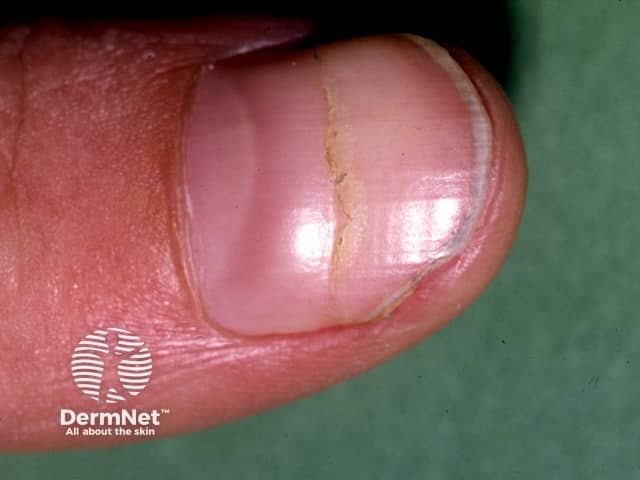
Beau line
A Beau line is a transverse depression affecting all nails, due to acute systemic illness stopping nail growth.

Effect of ageing

Lichen planus

Darier disease
Onychorrhexis is longitudinal ridging of the nail plate. Consider ageing, lichen planus, psoriasis, fungal nail infection and Darier disease or a habit of picking.

Nail trauma 4 months earlier
A horizontal groove can be the result of earlier nail trauma or subungual haematoma.
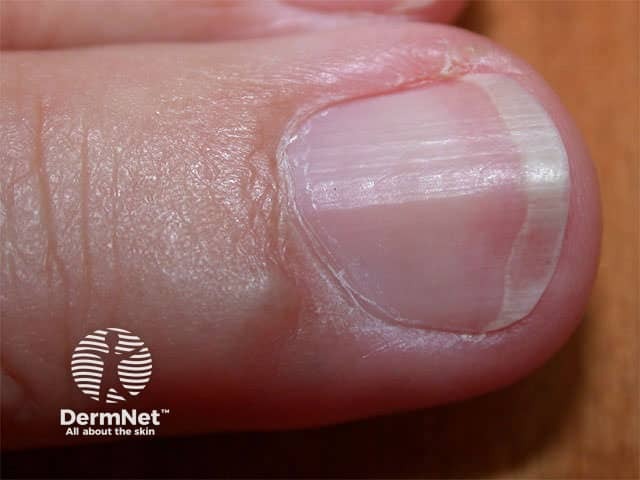
Myxoid cyst
A longitudinal groove in the nail plate is due to myxoid cyst or wart overlying the proximal nail matrix.


Median canaliform nail dystrophy
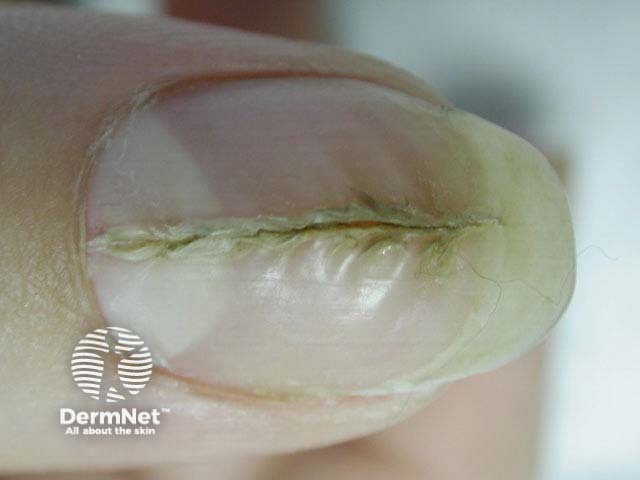
Median canaliform nail dystrophy presents as a feathered, central, longitudinal ridge with a fir-tree pattern usually involving both thumbnails. It is similar to the deformity caused by repetitively pushing back the cuticle (habit-tic deformity). Macrolunulae (large half-moons) may expose the nail matrix to trauma, as they are frequently present.
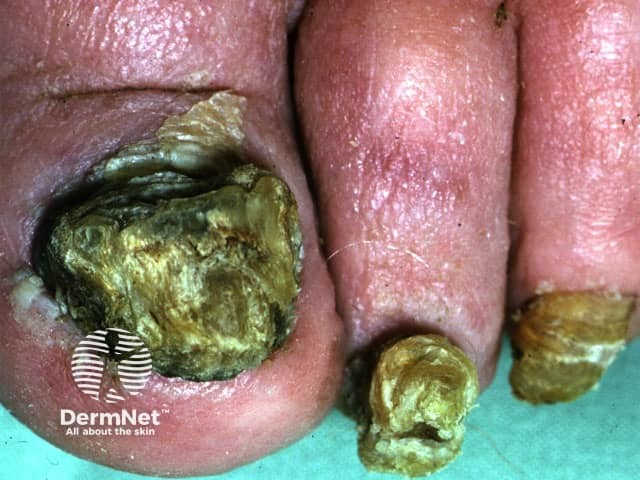
Onychogryphosis


Onychogryphosis
Onychogryphosis is a thick hard curved nail plate in the shape of a ram's horn usually due to ageing, psoriasis or trauma.

Psoriasis

Fungal nail infection
Onychauxis is a thick nail due to psoriasis, trauma or fungal nail infection.

Angelwing deformity
Angel-wing deformity describes nail plate thinning due to lichen planus.

Psoriasis
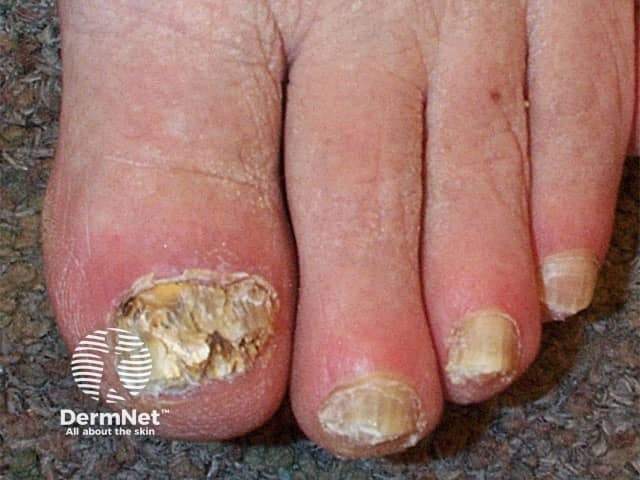
Fungal nail infection
Nail plate crumbling is typical of psoriasis and fungal nail infection.
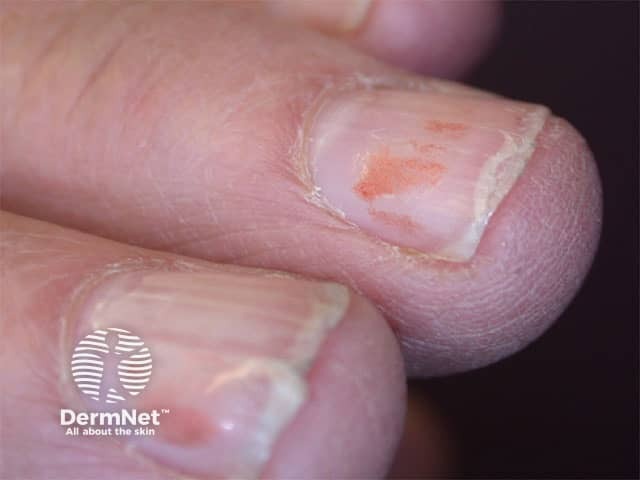
Nail splitting: onychoschizia
Onychoschizia is distal lamellar or splitting/brittle nails due to water/detergent damage.

Fungal nail infection

Longitudinal nail splitting is an extension of ridging seen in psoriasis, a fungal nail infection or lichen planus. Distal splitting in association with a pigmented or red linear band can be a sign of onychopapilloma.

Darier nail disease
Distal notching of the nail occurs from trauma, Darier disease, and lichen planus.
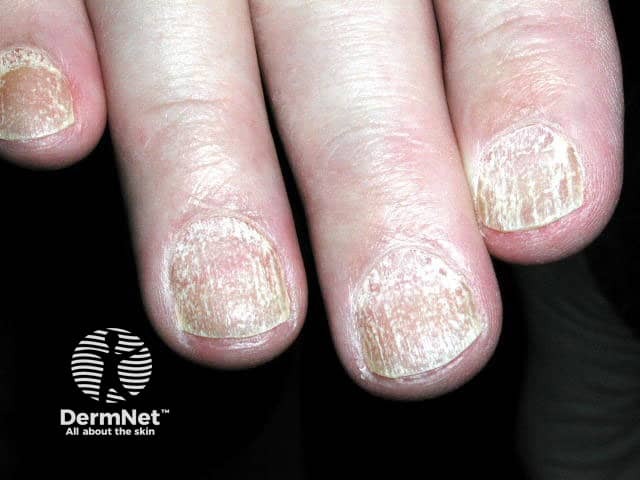
Trachyonychia
Trachyonychia means rough nails. Trachyonychia is characteristic of lichen planus. Twenty nail dystrophy is trachyonychia of all nails.

Melanoma
Nail erosion is due to trauma or malignant tumours, such as squamous cell carcinoma or melanoma.

Acrylic nail

Nail cosmetics
These images show acrylic nails used as decorative cosmetics.
Distinguish a discoloured nail bed from a discoloured nail plate.

Yellow nail syndrome
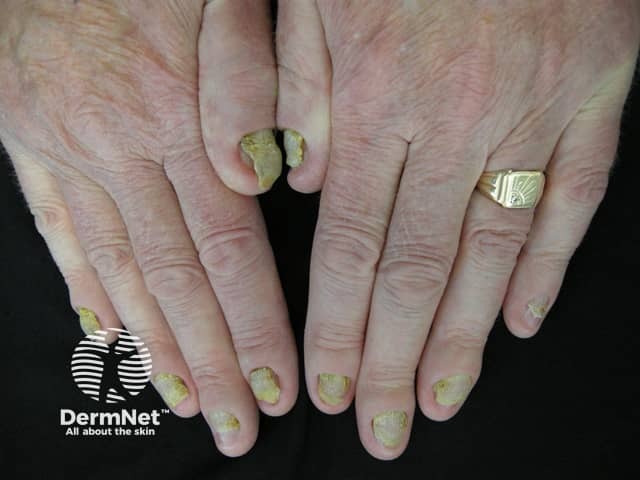
Yellow nail syndrome
Yellow nail syndrome refers to multiple yellow nails due to lymphatic obstruction in cardiopulmonary disease.

Pseudomonas/candida infection
Green nails are associated with Pseudomonas or Candida infection.
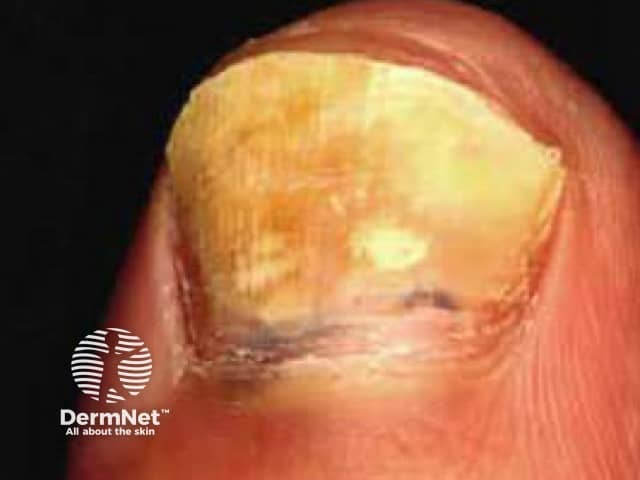
Fungal nail infection

Due to dermatophyte onychomycosis
See onychomycosis.

Nail psoriasis

Psoriatic nail dystrophy
Yellow nails in psoriasis is due to onycholysis, lifting of the nail plate from the nail bed (see below).

Podophyllin

Oral hydroxyurea

Nail dystrophy due to lichen planus

If nails are brown coloured, consider staining (nicotine, potassium permanganate, nail varnish) and chemotherapy. Illustrated are staining from podophyllin and streaks due to oral hydroxyurea. Brown nails may also be due to onychomycosis and in dark-skinned individuals, inflammatory conditions like lichen planus. See also melanonychia and multiple brown linear streaks below.

White nail due to vitiligo
White nails. Consider hypoalbuminaemia or chronic renal failure. May also be familial. Transverse leukonychia, in which there are multiple parallel white lines, is thought to be due to manicuring. It may also arise in association with Beau lines.

White spots on nail

White spots on nails

Transverse leukonychia
These images show white streaks due to trauma, such as manicuring.
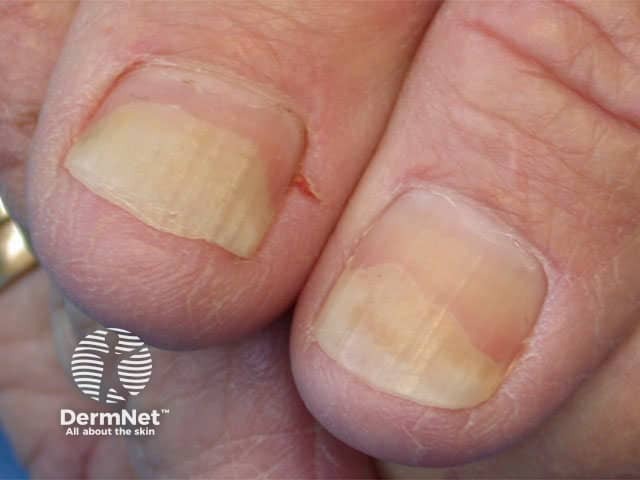
Idiopathic causes

Psoriasis

Candida

Tetracycline
These images show the lifting of the distal nail plate, which appears white or yellow. Consider idiopathic causes, trauma, psoriasis, thyrotoxicosis, irritant and allergic contact dermatitis, fungal nail infection (candida), drug photosensitivity (especially tetracycline and psoralens)

Onychomycosis
Superficial white onychomycosis

Half and half nail
Half-and-half nails occur in renal failure as a white proximal nail, with a brown distal nail.

Terry nail
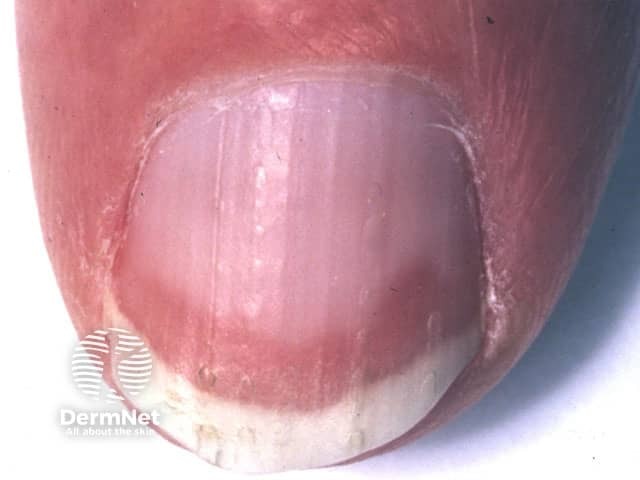
Terry nail
Terry nail occurring with liver cirrhosis presents as a white proximal nail, and reddened distal nail.
Mee lines are partial leukonychia due to arsenic intoxication or systemic disease.

Muehrcke nail
Muehrcke lines are a double band of leukonychia in renal disease.

Red lunula

A red longitudinal streak or erythronychia is often due to onychopapilloma.

Darier disease
See Darier disease.
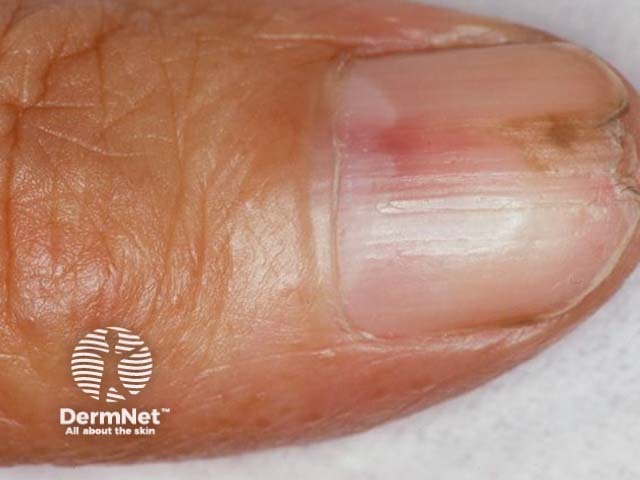
Glomus tumour

Glomus tumour
If a red spot is tender, consider glomus tumour.

Blue nails due to minocycline
If nails are discoloured blue, consider drugs if all nails are affected, in this case, due to minocycline.
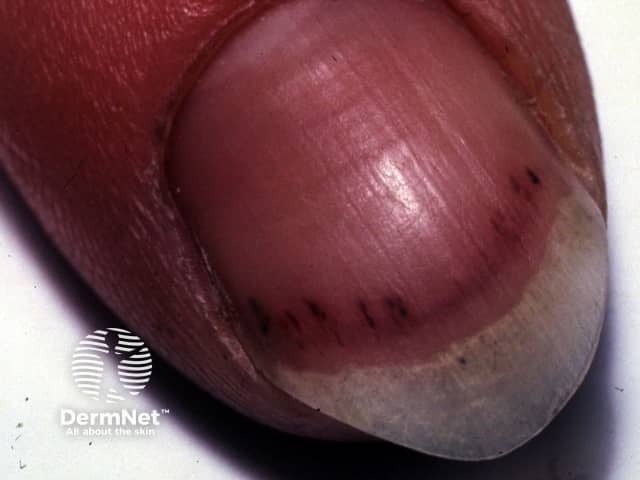
Splinter haemorrhages
A red or purple streak is known as a splinter haemorrhage.
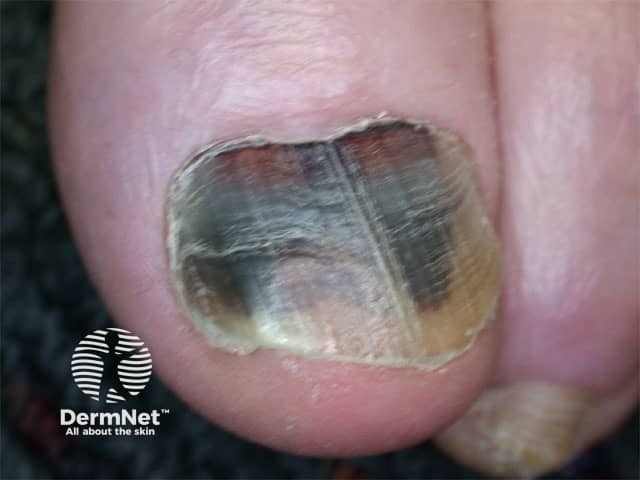
Subungual haematoma
Subungual haemorrhage or haematoma (blood clot) causes a purple or black discolouration.

Black nails with pseudomonas infection
A black nail may be due to a pseudomonas infection
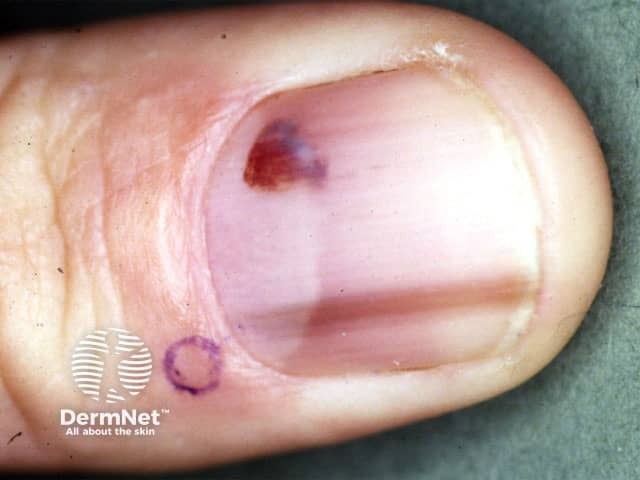
Melanonychia
Melanonychia is a brown/black longitudinal band due to benign melanocytic naevus.

Multiple melanonychia
Longitudinal melanonychia may be of racial origin, Laugier-Hunziker syndrome. Rarely due to drug (azidothymidine, tetracycline), endocrine disorders or Peutz-Jeghers syndrome.


Consider melanoma.
The cuticle is a sheet of keratin joining the skin of the proximal nail fold to the nail plate, protecting the space under the proximal nail fold. Loss of cuticle results in paronychia.

Ragged cuticles
Ragged cuticles are characteristic of connective tissue disease, and also occur in parakeratosis pustulosa.

Hang nail
Hangnail can be due to trauma (eg, nail biting).
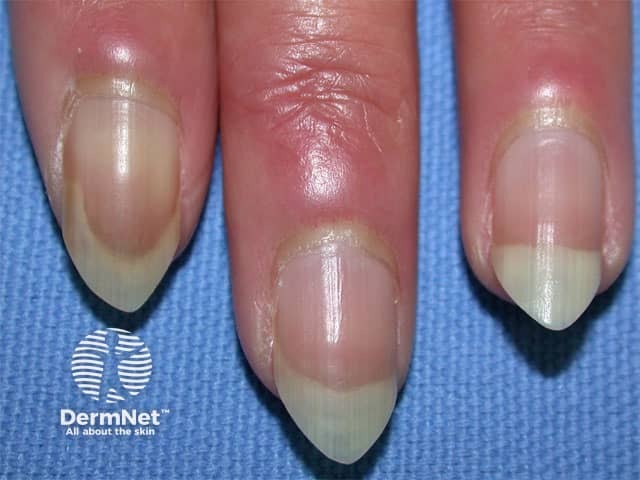
Nail fold telangiectasia
Nail fold telangiectases are characteristic of connective tissue disease, for example, lupus erythematosus.

Distal digital infarcts
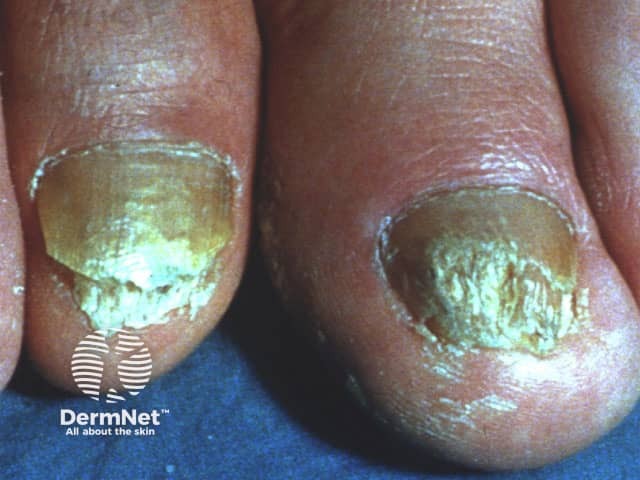
Psoriasis

Scabies
Subungual hyperkeratosis is scaling under the hyponychium. Typical of psoriasis and onychomycosis, it is also seen in crusted scabies.

Pterygium of nail due to lichen planus
A pterygium is a wing of extra tissue. In a nail, it is due to scarring in the matrix. Characteristic of lichen planus, but may also occur in Stevens-Johnson syndrome and after trauma.

Acute paronychia
Staphylococcus aureus is the main cause of acute paronychia.

Acute herpetic paronychia
Herpes simplex is another common cause of acute paronychia (see Herpetic whitlow).
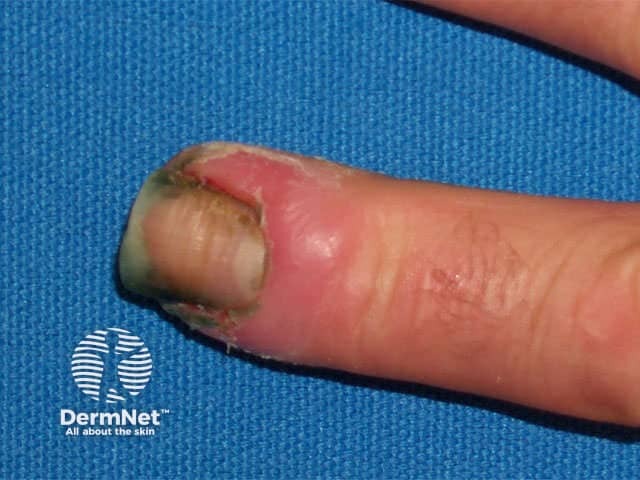
Chronic paronychia
Chronic paronychia is associated with dermatitis, and infection with Candida albicans and Pseudomonas.

Acrodermatitis continua
Acrodermatitis continua of Hallopeau is a form of severe psoriasis
Retronychia refers to the embedding of the proximal nail plate into the proximal nail fold with subsequent painful nail fold inflammation and thickening, and granulation tissue, usually seen in the great toes. It typically results from trauma pushing the nail plate up with a new plate growing out underneath. Treatment is the removal of the nail.

Osteoid osteoma (bone tumour)

Uncut
Short nail
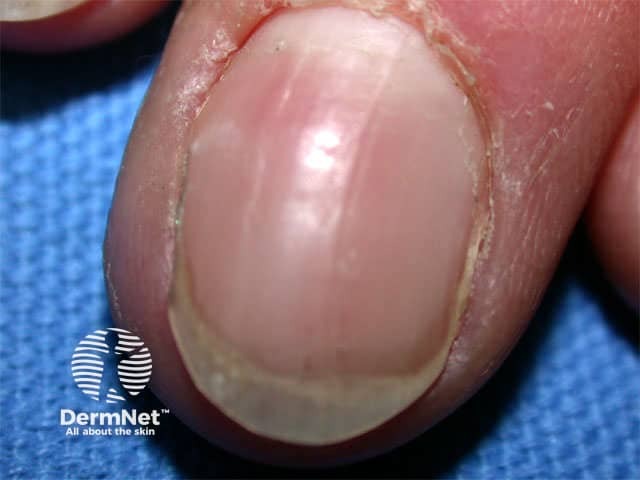
Resorption of distal phalanx
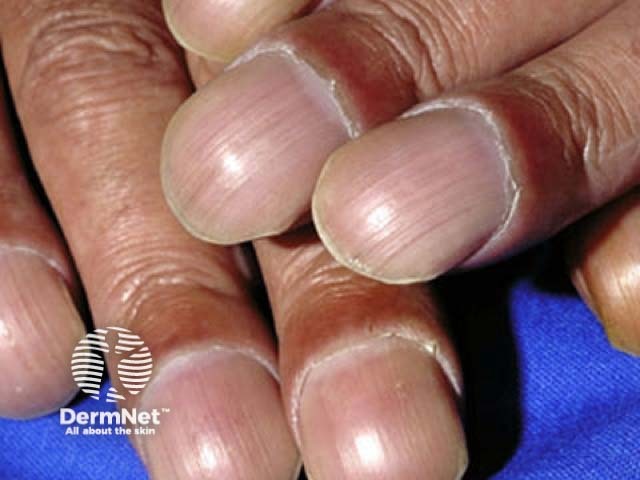
Clubbing is due to hypertrophic osteoarthropathy or thyroid disease (acropachy); see hypertrophic osteoarthropathy.

Koilonychia
Koilonychia is a thin, spoon-shaped nail, and can occur in normal children and adults. It is also associated with iron deficiency anaemia, diabetes, protein deficiency, connective tissue disease, nail exposure to solvents and acitretin treatment.
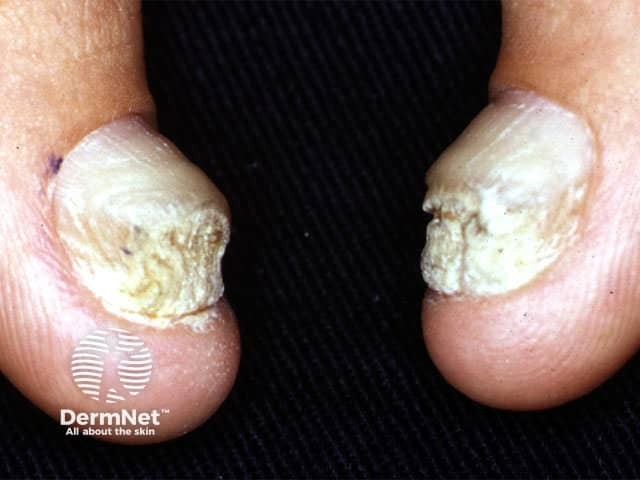
Pachyonychia

Pincer nail is sometimes familial or associated with psoriasis.
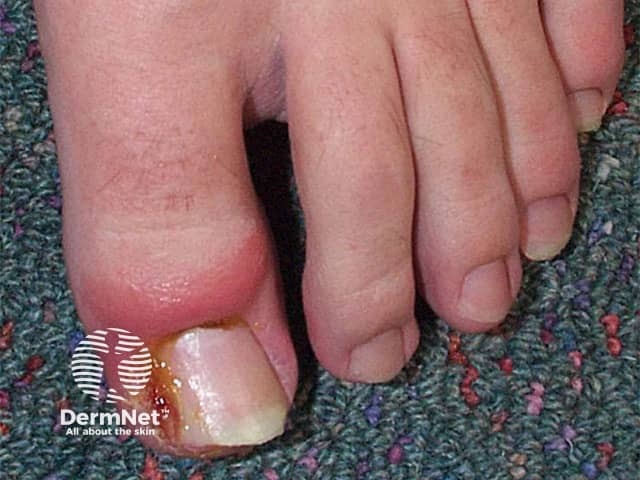
In-growing nail with granuloma formation aggravated by an oral retinoid
Onychocryptosis is commonly known as an in-grown nail, and involves the lateral nail folds with granuloma formation. Often aggravated by oral retinoids, isotretinoin and acitretin.

Nail biting

Bitten nail
Usually, traumatic, such as nail-biting; in children parakeratosis pustulosa
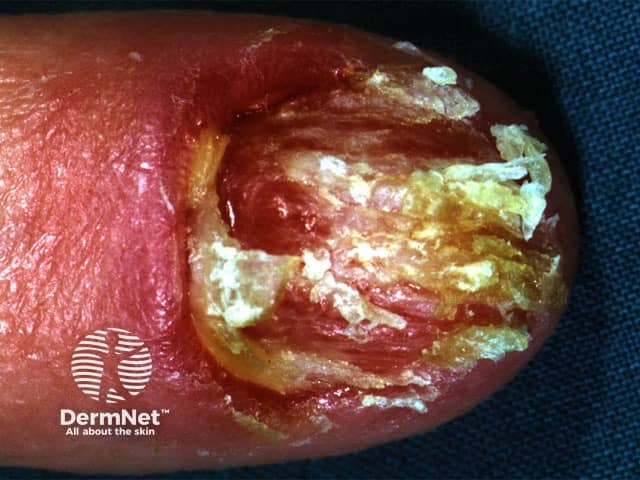
Due to tumour


Nail shedding due to lichen planus

Common skin lesions around nails include:

Periungual warts

Melanonychia
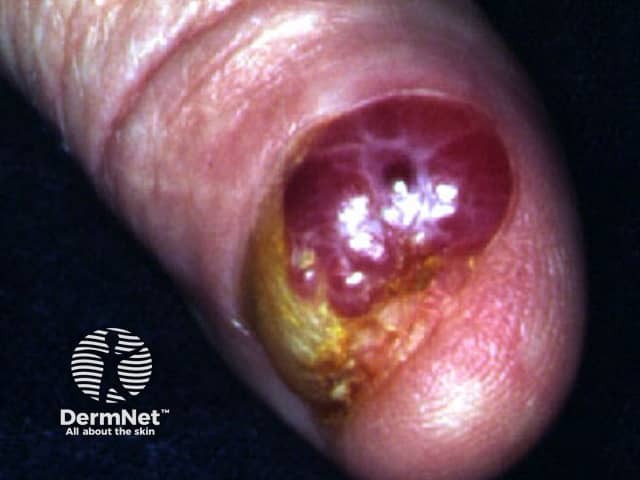
Subungual melanoma



Periungual fibroma


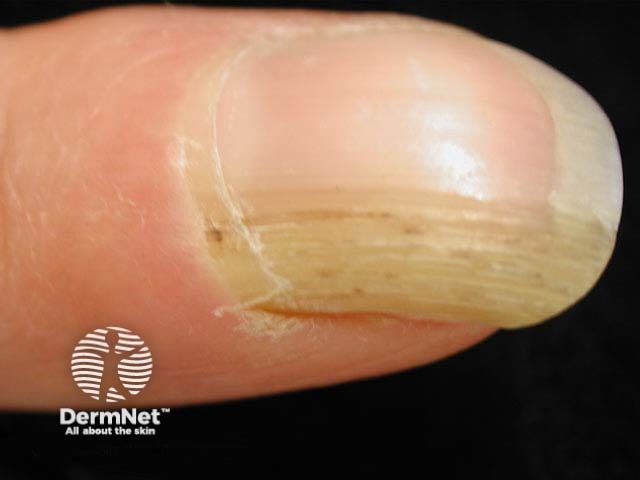

Subungual exostosis

Giant cell tumour of tendon sheath
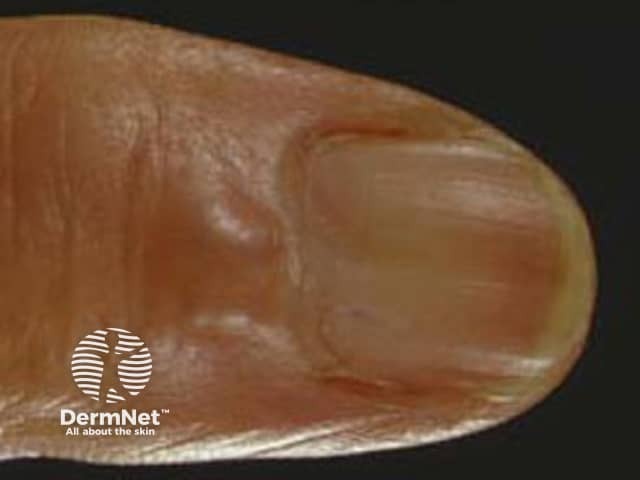
Myxoid cyst
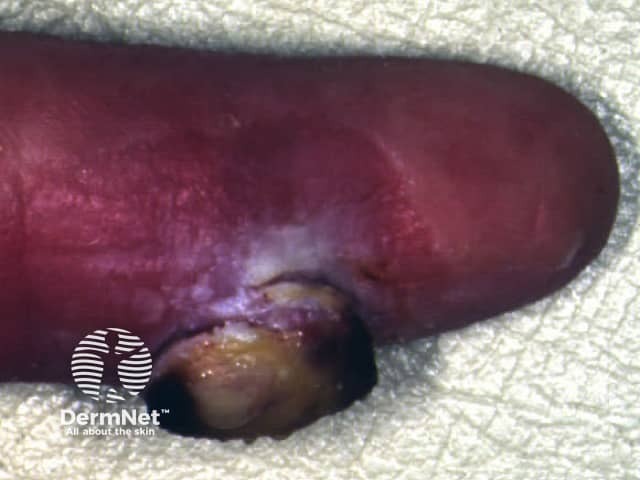
Periungual pyogenic granuloma